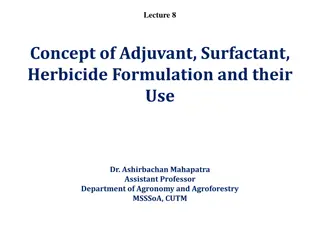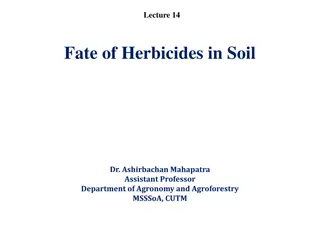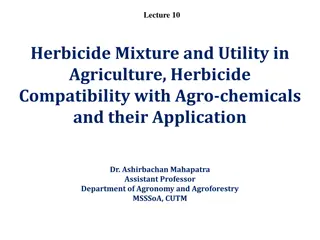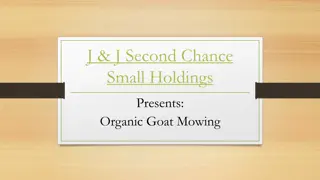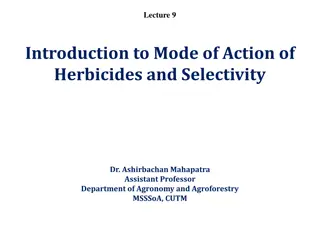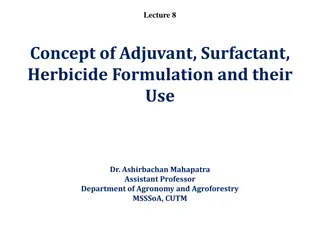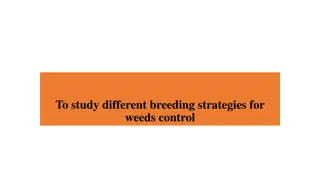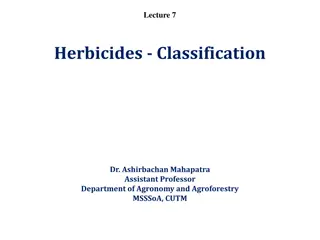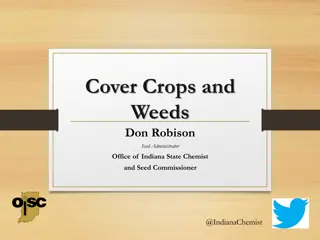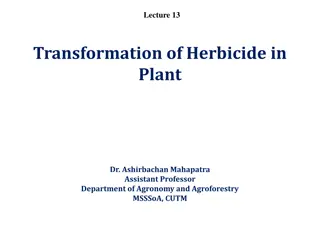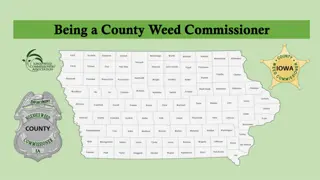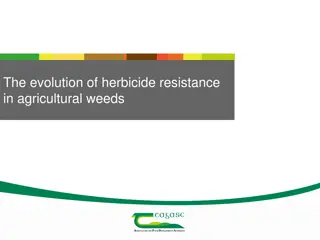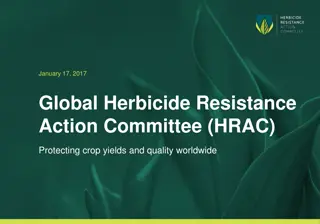Integrating Herbicides with Non-Chemical Weed Management Methods
The concept of weed management involves methods to enhance crop growth while discouraging weed invasion. Evolution shows the progression from manual labor to chemical methods. Weed management principles include eradication, prevention, and control. Eradication involves complete removal of weeds, while prevention focuses on halting weed entry and establishment. Effective weed management is crucial for agricultural success and sustainability.
Download Presentation

Please find below an Image/Link to download the presentation.
The content on the website is provided AS IS for your information and personal use only. It may not be sold, licensed, or shared on other websites without obtaining consent from the author. Download presentation by click this link. If you encounter any issues during the download, it is possible that the publisher has removed the file from their server.
E N D
Presentation Transcript
Lecture 11 Integration of Herbicides with Non-chemical Methods of Weed Management Dr. Ashirbachan Mahapatra Assistant Professor Department of Agronomy and Agroforestry MSSSoA, CUTM
Definition and Concept of Weed Management Weed management is the application of certain principles and suitable methods that will improve the vigor and uniform stand of the crop. At the same time ignore or discourage the invasion and growth of weeds. Evolution of Weed Management: (6 Stages) 1. 10,000 BC Removed by hand 2. 6000 BC Weeds removed by primitive hand tools 3. 1000 BC Weeding done with the help of animal drawn implements 4. 1920 AD Machine drawn implements were used for weeding 5. 1930 AD Weeding was taken up by biological agents 6. 1947 AD Weeding by chemical methods (Organic herbicides)
Methods of weeds management Weed control and weed management are the two terms used in weed science. Weed control is the process of limiting infestation of the weed plant so that crops can be grown profitably, where as weed management includes prevention, eradication and control by regulated use, restricting invasion, suppression of growth, prevention of seed production and complete destruction. Thus weed control is one of the aspects of weed management. Principles of Weed Management are 1. Eradication 2. Prevention 3. Control
1. Eradication It is complete removal of all live plant parts and seeds of the weed from an area. It may be a field/farm/village/geographical region depending upon the need. In general eradication of common weed seeds is not practiced as these weeds harbor crop pests or secretes soil nematicide compounds. They may be useful to hold the soil nutrients against leaching losses during fallow period. However weed eradication is justified against weeds like Striga, Cuscuta, Lantana to prevent their dispersal to new areas of useful land and water bodies. Weed eradication programme should begin when the weed growth is limited. If the weed occupied large and continuous areas eradication is not economical. It should be carried out more than one year. It requires intensive initial efforts to destroy all plant parts and followed by many years of vigilance to prevent the new weed seedlings from establishing into adult plants.
2. Prevention Prevent the entry and establishment of weeds into uninfected area. It encompasses all measures taken to prevent the introduction and/or establishment and spread of weeds. Such areas may be local, regional or national in size. No weed control programme is successful if adequate preventive measures are not taken to reduce weed infestation. It is a long term planning so that the weeds could be controlled or managed more effectively and economically than is possible where these are allowed to disperse freely. Arresting the movement and denying the entry in uninfested area. Crop hygiene can also be considered as prevention. Weeds producing seeds in current season are the inoculum for next season. If some how they do not produce seeds in current season, this is also one of the preventive measures. Thus controlling weeds at flowering stage, which will prevent contamination in other season, is also a preventive measure. Important weed prevention practices are 1. Use clean crop seeds/ weed free crop seed 2. Avoid feeding of screenings, grain or hey containing weed seeds to live stock without destroying their viability by grinding, cooking and ensiling. 3. Use well rotten/decomposed organic manure. Avoid reaching of weed seeds into the compost pit 4. Prevent movement of weeds with other farm resources 5. Keep non crop area clean 6. Use vigilance 7. Follow legal & quarantine measures
3. Control Weed infestations are reduced but not necessarily eliminated. Weed control includes: 1. Physical or Mechanical methods 2. Cultural methods 3. Chemical methods (Not used in Organic Weed control) 4. Biological methods
Chemical methods Herbicides are chemicals capable of killing or inhibiting the growth of plants. Today we have 150 herbicides in common use for selective and non selective control in different areas. Historical Development of Herbicides Common salt, ash etc. have been used for centuries to control weeds on roadsides, fence rows & pathways. But Selective control of weeds in Agriculture was first conceived in 1896 with the chance observation of French farmer that Bordeaux mixture sprayed on Grape vine to control downy mildew damaged certain broad leaved weeds. It was found CuSO4 present in the Bordeaux mixture was responsible for its weed killing effect. Between 1896 and 1908 several inorganic salts as also sulphuric acid were found selective to small grain crops. A real breakthrough in selective weed control was achieved in 1945, with the discovery of 2,4-D & MCPA in USA & England independently by P.W. Zimmerman and A.E Hitchkock. Both 2,4-D and MCPA were found highly selective for cereals and phytotoxic to broad leaved weeds. In Agriculturally developed countries, herbicides form over 45% of the total pesticides used. In India, share of herbicides is only 8% of the total pesticides consumed. The average herbicide usage in India is 40g/ha/year as against 675-1350 g/ha/year in many advanced countries. While in Japan it is as much as 5,000g/ha/year. The present annual capacity of herbicide production in India is about 6000t ha-1. About th of the available herbicides in India are used in plantation crops.
Chemical methods Objectives of herbicides usage 1. The primary objective of introducing herbicides in Agriculture is to replace the drudgery of manual weeding. 2. The labour power could be utilized more effectively for brining additional land under cultivation and for improving the overall Agricultural production. 3. Increasing costs of hired labour and limited supply of fuel for mechanical weed control. 4. Herbicides are not aimed at substituting the Physical, Biological or good crop husbandry methods. These are only meant to bridge the gap in these methods. 5. In water bodies herbicides can be efficiently employed to free them of their weedy vegetation that hinder the proper water use.
Biological methods Utilization of natural living organism, such as insects, herbivorous fish, other animals, disease organisms and competitive plants to limit their growth. In biological control method, it is not possible to eradicate weeds but weed population can be reduced. This method is not useful to control all types of weeds. Introduced weeds are best targets for biological control. The control Opuntia spp (prickly pear) in Australia and lantana in Hawai with certain insect bioagents are two spectacular examples of early period biological control of weeds. Merits 1) Least harm to the environment 2) No residual effect 3) Relatively cheaper and comparatively long lasting effect 4) Will not affect non-targeted plants and safer in usage 5) It is very effective in control of weeds in non cropped areas 6) Besides this some of the fish, snails and other animals convert weed vegetation into seafood Demerits 1) Multiplication is costlier 2) Control is very slow 3) Success of control is very limited 4) Very few host specific bio-agents are available at present
Biological methods Biological control started in the year 1900. There are 2 approaches in biological control. 1. Classical biological control approach. 2. Bio-herbicide philosophy approach. Classical biological control Main objective of classical biological weed control is restoring balance between target alien weed and its natural enemies in the ecosystem by introduction of suitable, exotic bio-agent. Successful bio-agent reduce the weed population first then the Bio-agent population due to starvation of food. After some time the bio-agent population may recover. This process continues in cyclic fashion till the bio-agent and weed population gets established at a low level. This method is a slow operating and currently used in non cropped areas. In crop fields, the bio-agent will not get opportunity to work on host weed due to frequent use of insecticides and fungicides in modern agriculture. Other wise Cyperus rotundus can be controlled in crop fields with moth Bactra verutana . and selective bio control of Ludwigia parviflora (water purslane) by Haltica cyanea (steel blue beetle ) in rice fields. Criteria / Characteristics of successful bio-agent 1. Host-specific 2. Bioagent hardiness 3. Feeding habit and 4. Ease of multiplication
Biological methods 1. Host-specific Bio-agents should be host specific and they should not attack other economic plant spp. They should pass starvation test i.e. they prefer to starve to death rather feed upon other than host weeds. Lantana was controlled by Teleonemia scrupulosa insect bio-agent. But in India it is likely to damage teak (Tectona grandis) and sesame (Sesamum indicum). Zygogramma bicolarata is an effective leaf eating bio-agent against Parthenium (carrot grass). But it is found to attack sunflower in India. 2. Bioagent hardiness Bio-agent should free from its own parasites and predators. Bio-agent should withstand starvation for short or long periods of food shortage when the target weed population is brought to low level. But carp can t survive even a short period of starvation. 3. Feeding habit Bio-agents are more efficient in controlling weeds if they attack either flowers or seeds of the weed or bore into the stems than root and leaf feeders. But root-feeding insects are more effective in controlling perennial weeds. 4. Ease of multiplication Bio-agent should have high rate and ease of natural reproduction. It is very important for insects, pathogens, snails and competitive plants. But it is not desirable with carp as its increased population compete with natural fish.
Biological methods Kinds of classical bio-agents Bio agent may be either specific or non specific. Specific bio agent attack only one or two specific weeds, while non specific bio agent feed upon a variety of vegetation. Specific bio agents are insects, plant pathogens and competitive plants. Non specific bio agents are Carp fish, snails, mites. Six kinds of Bio-agents were used to control weeds. They are Insects, Carp fish, Fungi, Competitive plants, Snails and mites Insects These are largely host specific i.e one insect spp is employed to destroy the only one weed sp. First successful example reported from Hawai in 1902 Lantana camara controlled by Moth Crocidosema lantana . Insects that were found effective belong to Lepidoptera, Hemiptera, Coleoptera, Diptera. Carp fish Certain fresh water Carp fish consume large quantities of aquatic weeds. Whiteamur (Chines grass carp) Ctenopharyngodon idella is promising spp for aquatic weed control. This can grow more than its body weight i.e 5 kg/year and attaining up to 50 kg at its full size. Herbivorous fish are not food specific. Where as the common carp (Cyprinus carpio) a non herbivorous fish used to control submerged aquatic weeds.
Biological methods Plant pathogen Many fungi attack specific weed spp. For instance Acacia glauca controlled by spore suspension of Cephalosporium zonatum . Skeleton weed (Chondrilla juncia) controlled by rust causing fungi Puccinia chondrillana. Competitive plants Certain plants sp are very competitive in suppressing specific weeds. Slender spike rush ( Eleocharis acicularis ) aquatic plant can cover the canal bottom and it is not allowing to establish destructive tall weeds. Typha sp can be controlled by Panicum purpurascens or Brachiaria mutica (Para grass). Marigold has potential to displacing Parthenium spp. Slender spike rush ( Eleocharis acicularis ) aquatic plant can cover the canal bottom and it is not allowing to establish destructive tall weeds. Typha sp can be controlled by Panicum purpurascens or Brachiaria mutica (Para grass). Marigold has potential to displacing Parthenium spp. Cassia sericea also suppressed the Parthenium. The mite Tetranychus desertorum controls prickly pear Opuntia dellini Snails The large tropical fresh water snail Marisa cornuarietis feed on aquatic weeds. Marisa feed on roots of water hyacinth, water lettuce and leaves of Salvinia . Mite The mite Tetranychus desertorum controls prickly pear Opuntia dellini
Biological methods Outstanding example of classical bio-control Lantana Camera: Lantana was the first weed controlled successfully with certain insect bioagents in Hawaii..Of these Crocidosema lantana, a moth was found to be promising in destroying flowers and seeds of lantana. In Australia ,three successful insect biocontrol agents are hispine beetles (Octotoma scabripennis and Uroplata girardi) and tingid /lantana bug (Teleonemia scrupulosa). In Andhra Pradesh lantana has been controlled by some of these insects, besides the lantana seedfly (Ophiomyia lantanae.) Prickly pear (Opuntia sp): In Austrlia biocontrol of Opuntia inermis .with a moth Cactoblastis cactorum .In Tamilnadu and Maharashtra 40,000 ha land was recovered from the weed Opuntia delini by releasing Dactyloplius tomentosus . a Cochineal scale insect Alligator weed (Alternanthera philoxeroides) controlled by flee beetle: Agasicles hygrophyla and alligator weed thrips : Anynothrips andersoni Water hycinth: (Eichornea crassipes) it is world wide aquatic weed infested transplanted paddy fields including India. Hyacinth moth Sameodes albiguttalis feed up on young leaves and apical buds. Besides this beetles Neochetina bruchii and N. eichorniae are also damaging the water hyacinth Salvinia (Salvinia molesta): InKerala (India) curculionid beetle Cytrobagous salviniae used to clear the fresh water courses and paddy fields. They feed on terminal buds and rhizomes and petioles of salvinia.
Some other examples are Weed Bio-agent Reporting Country Kind of bio-agent Australia Plant pathogen Chondrilla juncea Puccina chondrillina Plant pathogen Cirsium arvense Septoria cirsii India, Pakistan, USA Shoot boring moth Cyperus rotundus Bactra verutana i) Emmalocera sp. ii) Tripos spp. i)Stem boring moth ii) Shrimp Echinochloa spp. (In rice fields) USA Plant pathogen Eupatorium riparium Entyloma compositarum USA Shoot fly Hydrilla verticillata Hydrellia pakistanae USA Plant pathogen Orobanche cernua Sclerotinia sp. i)Zygogramma bicolorata ii)Epiblema strenuana iii) Conotrachelus sp. India Australia Australia Leaf eating beetle Stem galling insect Stem galling insect Parthenium hysterophorus i) Uromyces rumicis ii)Gastrophysa viridula USA Plant pathogen Beetle Rumex spp. USA Pod weevil Tribulus terrestris Microlarinus lareynii and M. lypriformis
Integrated weed management Integrated method is a system which brings all feasible methods of weed control harmonizing them into a single and co-ordinated system designed to maintain weeds below those levels at which they cause economic loss . Principles of Integrated weed management 1. IWM place the crop in competitive advantage over the weeds by manipulating the crop habitat by utilizing some biological differences between crops and weeds. 2. In IWM measures should be directed to reduce the survival mechanism of weeds in the soil. 3. Crop cultural practices should be incorporated to discourage the establishment of the perennial and parasitic weeds. Eg: Crop rotation 4. Any individual element of the weed management should be eco friendly and it should not be harmful to the environment. 5. Weed management practices should be flexible to accommodate possible innovations and experiences of progressive farmers. Advantages 1. It shifts the crop-weed competition in favour of crop 2. Prevents weed shift towards perennial nature 3. Prevents resistance in weeds to herbicides 4. No danger of herbicide residue in soil or plant 5. No environmental pollution 6. Gives higher net return 7. Suitable for high cropping intensity





